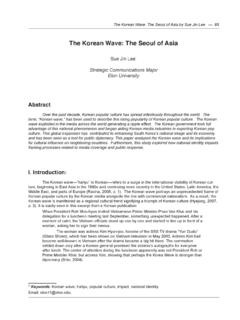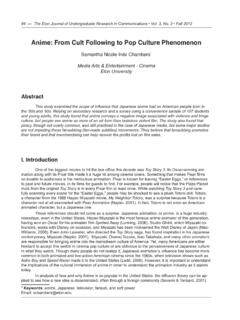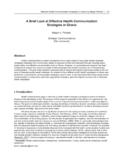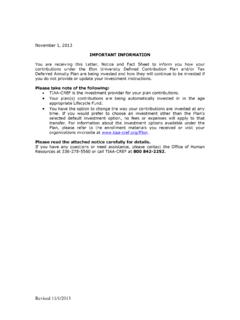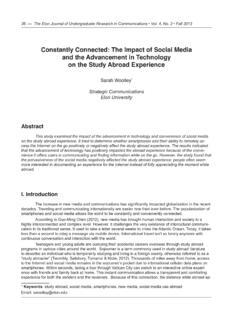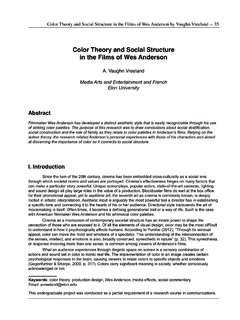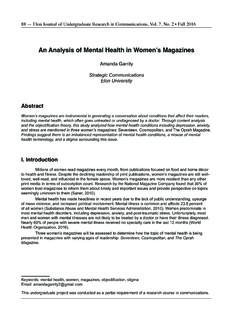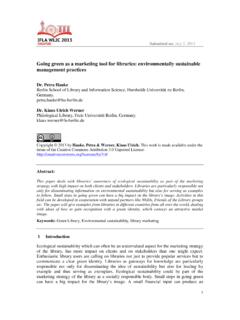Transcription of Examining Green Advertising and Its Impact on Consumer ...
1 78 The Elon Journal of Undergraduate Research in Communications Vol. 4, No. 2 Fall 2013 Examining Green Advertising and Its Impact on Consumer Skepticism and Purchasing PatternsLindsay Richards* Strategic Communications Elon UniversityAbstract The twenty-first century has seen a significant increase in environmental awareness and activism, which has ultimately developed into a pro-environmental trend. Similar to previous societal trends such as cigarette smoking and fashion fads, environmentalism has recently entered the Advertising world under the term Green Advertising . This research aimed to identify the Impact of Green Advertising through evaluating consumers connection to the environment, trust in Advertising and willingness to purchase Green products.
2 An analysis of 107 online survey responses indicated that consumers are generally skeptical of Green adver-tisements, and have clear motivating and deterring factors when purchasing Green products. This research is useful for advertisers, as it can help environmental firms understand and reach their target consumers more effectively. I. IntroductionThis research was designed to provide credible environmental companies with more effective and ethical ways of Advertising to their desired target audiences. Over the past couple of decades, the Green movement has become more and more of a presence in our society. Organic items are more readily available, fuel efficient vehicles are becoming more popular, and many consumers are looking to make an environmental difference no matter how small it may be.
3 The Green movement has also made its way into Advertising and the Consumer marketplace, where communicators are using the trend to spark Consumer interest and drive sales. Labels with Green color schemes, print advertise-ments with natural images and commercials boasting environmental claims both intentionally and sublimi-nally address the Green movement and are examples of what many refer to as Green Advertising . This research was structured to better understand Green Advertising s Impact on consumers. Howev-er, in order to understand the Impact of Green Advertising , one must first understand the Green Consumer . The success of an advertisement is critically dependent upon the advertisers ability to motivate action through Consumer -specific messages.
4 Therefore, this research investigated consumers connection to the environ-mental movement, their skepticism of Green Advertising and what motivates and deters them from making Green purchases.* Keywords: Green , Environmental, Advertising , Skepticism, ConsumersEmail: Green Advertising and Its Impact on Consumers by Lindsay Richards 79II. Literature ReviewMuch research has been conducted in response to the recent increase in Green Advertising in the and abroad. The effectiveness and Impact of Green Advertising is often difficult to gauge, as consum-ers actions are often dependent upon numerous subjective variables ( brand perceptions, ethical beliefs, product convenience, perceived product value, etc.). Therefore it was necessary to further investigate con-sumer environmental insights and their connectivity to Advertising and ultimately purchasing patterns in order to fully understand the relationship between Green Advertising and the Consumer market.
5 The following sections outline the methods of recent studies pertaining to Green Advertising and consumers. Consumers Responsiveness to AdvertisingThis section defined the relationship between advertisements and consumers on a general level. Consumers responsiveness to Advertising is critical to the effectiveness of an advertisement, and is, there-fore, a cornerstone in understanding the Impact of Green Advertising . In a society that is constantly digesting advertisements on all media platforms, consumers respond to Advertising content in many different ways. A particular response could either be driven by individual motives and preferences, or more collective and com-munal motives that are shared within a particular sub-culture or group.
6 These motives are then what ultimately shape Consumer insight in Advertising . Hilliard, Matulich, Haytko & Rustogi (2012) stated that a Consumer s response to an advertisement will directly Impact either negative or positive brand perception, ad skepticism or ad activism ( product purchase). Recent studies explained such responses through the application of the Theory of Reasoned Action. This theory describes the relationship between individuals beliefs, attitudes, intentions and behaviors (Hilliard et al., 2012). Furthermore, an individual will have a favorable attitude toward a behavior if they believe it will lead to a positive outcome, and vice versa. This theory has been used to explain why people choose to en-gage or not engage in certain actions, and can help predict one s behavioral response to various interventions ( advertisements).
7 Advertisements are thus created with this theory in mind, and are designed to change not only behaviors themselves, but also the beliefs that will, in turn, change behavior and drive a desired ac-tion or purchase (Coleman, Bahnan, Kelkar & Curry, 2011). Such concepts are critical to understanding one s responsiveness to Advertising , in light of preconceived attitudes/ beliefs and their level of flexibility. The Many Shades of GreenThis section investigated the complexity of the Green movement and its relation to Advertising . In order to fully understand the perceptions, effectiveness and Impact of Green Advertising , one must first define the term Green . That being said, most studies are in agreement that there are many shades of Green con-sumers, products and advertisements.
8 A product s level of greenness is gauged by various elements such as recyclable packaging, all natural, organic ingredients or eco-friendly production, consumption and disposal standards. While these are just a few examples, research has shown that such claims are most frequently associated with products that are considered Green . A Consumer s level of greenness is commonly gauged by their actions and behaviors. Environ-mental enthusiasts may partake in a wide range of Green activities such as recycling, energy conserva-tion, purchasing energy efficient appliances, joining sustainability programs, etc. (Coleman et al., 2011). The complexity then lies within one s frequency and consistency of environmental actions and behaviors.
9 Is the non-recycler with an electric car considered more or less Green than the avid recycler driving a Hummer? Such variances allow advertisements to create a wide window of content applicable to whichever shade of Green Consumer they re strategically targeting. An advertisement s level of greenness is a bit trickier to gauge. Researchers have labeled an adver-tisement as Green due to various elements such as stating environmental claims, the highlighting of Green product attributes, or the placement of natural images/symbols into the advertisement s design. Leonidas, Palihawadana & Hultman (2011) measured the level of greenness in particular advertisements as being shal-low, moderate or deep in complexity.
10 Their findings concluded that of the 473 advertisements analyzed, most claims exhibited either shallow or moderate greenness. No further research has been conducted in order to clarify the scale of an advertisement s greenness. 80 The Elon Journal of Undergraduate Research in Communications Vol. 4, No. 2 Fall 2013As detailed above, the various shades of Green in both advertisements and Consumer enthusiasm have lead to falsifications and skepticism of environmental claims. Researchers have coined this action with the term greenwashing, which is defined as the disinformation disseminated by an organization so as to present an environmentally responsible public image (Mitchell & Ramey, 2011). Recent years have shown a dramatic increase in companies that utilize greenwashing, resulting in Consumer doubt regarding ethical practices of various organizations.
